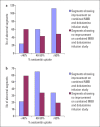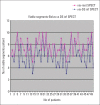Does myocardial viability detection improve using a novel combined 99mTc sestamibi infusion and low dose dobutamine infusion in high risk ischemic cardiomyopathy patients?
- PMID: 32749255
- PMCID: PMC7460678
- DOI: 10.14744/AnatolJCardiol.2020.99148
Does myocardial viability detection improve using a novel combined 99mTc sestamibi infusion and low dose dobutamine infusion in high risk ischemic cardiomyopathy patients?
Abstract
Objective: Early identification of viable myocardium in ischemic cardiomyopathy (ICM) patients is essential for early intervention and better clinical outcome. 99mTechnetium (99mTc) sestamibi gated myocardial perfusion imaging (gMPI) is a well-established technique for myocardial viability evaluation. Detection of potentially viable segments is a predictor of hibernating myocardium. ICM patients with hibernation have a better prognosis after revascularization. We used a novel infusion technique to determine better viability detection preoperatively in challenging situations. Like thallium, does prolonged availability of sestamibi in circulation with additional low dose dobutamine steady infusion (DS Inf) facilitate improved myocardial viability?
Methods: A total of 58 ICM patients with infarct and left ventricular ejection fraction (LVEF) <45% underwent 99mTc sestamibi bolus injection followed by slow intravenous infusion single-photon emission computed tomography (SPECT) using a 2 day protocol. After acquiring the second set of 99mTc sestamibi infusion images, a third SPECT gMPI was performed during DS Inf.
Results: A 17-segment myocardial model was used; 52 of 58 patients (548/986 segments) demonstrated perfusion defects (nonviable myocardium) on bolus study. Only 24 patients demonstrated viable segments by standard bolus imaging protocol. The slow MIBI infusion study demonstrated 158 viable segments (12 ICM patients), while combined infusion (99mTc sestamibi+DS Inf) exhibited an additional 6 patients with improved myocardial viability. Thus, 18 high risk patients benefited by this novel infusion technique to demonstrate viable myocardium on SPECT. There was a significantly higher sensitivity (p=0.05) and positive predictive value (p=0.01) in viability identification with the combined DS Inf technique. In dysfunctional segments, the rate of concordance for detecting viability between infusion and bolus techniques was 65%. Paired t test showed statistically significant improvement in viability detection with combined infusion compared to the bolus study (p=0.001).
Conclusion: This novel infusion technique was shown to be feasible and incremental in viability detection in ICM patients with severe left ventricular dysfunction. It is a robust tool to guide revascularization, in high risk ICM patients. This study also showed that patients with large transmural MI demonstrated no significant improvement in myocardial perfusion status using either protocol.
Conflict of interest statement
Figures







References
-
- Erthal F, Wiefels C, Promislow S, Kandolin R, Stadnick E, Mielniczuk L, et al. Myocardial Viability:From PARR-2 to IMAGE HF - Current Evidence and Future Directions. Int J Cardiovasc Sci. 2019;32:70–83.
-
- Hwang SJ, Melenovsky V, Borlaug BA. Implications of coronary artery disease in heart failure with preserved ejection fraction. J Am Coll Cardiol. 2014;63:2817–27. - PubMed
-
- Worsley DF, Fung AY, Jue J, Burns RJ. Identification of viable myocardium with technetium-99m-MIBI infusion. J Nucl Med. 1995;36:1037–9. - PubMed
-
- Giordano A, Trani C, Lombardo A, Maseri A. Detection of hibernated myocardium using intracoronary technetium-99m-sestamibi. Q J Nucl Med. 1997;41:46–50. - PubMed
MeSH terms
Substances
LinkOut - more resources
Full Text Sources

